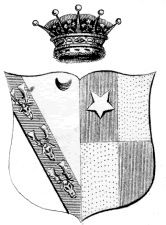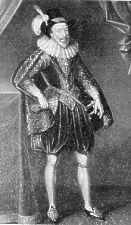On the death of the fifth earl a serious difficulty arose in reference to the succession, in consequence of a
default of male issue, and the absence of his brother William, who had not been heard of for years. During the lifetime
of his father, William displayed an ungovernable love for travel, and the earl consented to his going abroad for three years-
But as soon as Sir William was get on ship board
He to himself did secretly say,
I'll make a vow to the living Lord.
That three seven years I'll make away.
He remained three years in France, where he took laurels in many of the chief tournaments, and subsequently proceeded
to Spain, where he was challenged by a Spanish nobleman to single combat. In the first encounter the Spaniard succeeded
in wounding Sir William on his right arm, and causing him to fall to the ground, but he was soon upon his feet again.
In the second round the Spaniard aimed three deadly blows at the wounded Englishman, but they were all skillfully averted,
and Sir William gave his adversary a thrust on the right breast, inflicting a severe wound, and causing him to reel to
the ground. Blood flowed freely, and the friends of the Spanish nobleman counselled his withdrawal from the contest, but
he was too enraged to heed their advice, and in the third encounter rushed at Sir William with the force of desperation,
but the blows were successfully parried, and the representative of the house of Stanley once more secured the crown of
victory by inflicting a second wound on the breast of the Spaniard, and thus effectually disabling him. Sir William next
visited Italy, where he assumed the garb of a mendicant friar for the purpose of gaining information and the more readily
getting through the country. Afterwards he proceeded to Egypt, and with the assistance of a native guide, went to reconnoitre
the River Nile. Whilst on their journey, a large male tiger suddenly appeared from behind a thicket, and with a hideous
howl came rushing towards them. Sir William had two pistols, and discharged one as the tiger was making a spring at them.
Unfortunately he missed his aim, and it was only by dexterously stepping aside that he eluded the grasp of the ferocious
brute. Before the animal had time to take another spring, Sir William drew a second pistol, discharged the contents into
the tiger's breast, and as it reeled drew his sword and killed it. After paying a visit to Palestine, he journeyed to
Turkey, and had a narrow escape of becoming a victim to the bigotry of the followers of Mahommed. In a discussion with
one of the Paschas he defended Christianity and the Bible, and denounced the religion propounded in the Koran as false
and deceptive. He was arrested for "blasphemy against the religion of Mahommed," and after being kept a long time in a
filthy and dismal prison, a date was fixed for his execution, but a lady interceded on his behalf, and three days before
the appointed time he was liberated. Having remained some time at Constantinople, he visited Russia, and it is said that
whilst at Moscow he was informed by an English physician of the death of his father and brother, and that he thereupon
returned to his native land with all speed.
On Sir William reaching England, he found that all the estates of the earldom had been settled upon his brother's daughters,
under the guardianship of four bishops and four temporal lords, who possessed every branch of it to their ward's uses,
and refused to admit his right to any share of it. Having few friends and less money, and having powerful adversaries
to contend against, his case was somewhat distressing ; but some of the old tenants in and about Latham, Dalton, Newburgh,
&c., who knew him from a child to be their natural and rightful lord, supplied him with money to recover his title
and so much of the estates as properly belonged to him. A law suit, therefore followed, in reference to all the late earl's
estates in England and also in the Isle of Man. During the dispute the real title of the Stanley family to the Isle of
Man was called in question, on the ground that when Henry IV. granted it for life to Sir John Stanley, the Earl of Northumberland
(the former possessor) had not been attainted by Parliament nor his possessions adjudged to be confiscated, and that the
subsequent gift of it to Sir John, being founded upon the grant for life, was invalidated. Ultimately it was decided by
the law lords that the right to the Isle of Man belonged solely to Queen Elizabeth ; but Her Majesty, in consideration
of the "many eminent services performed to herself and to her royal predecessors by the honourable and noble House of
Stanley," withdrew her right and referred the contending claimants to the decision of the courts. The law proceedings
were continued with vigour on both sides for six or seven years, and would have extended over a still longer period, but
the Queen proposed a reference, and this being accepted, the whole matter was considered by Lord Burleigh, Lord Buckhurst,
the Earl of Dorset,, the Earl of Cumberland, Lord Hunsdon, and the Earl of Salisbury, who appointed and yielded to the
Right Honourable William, Earl of Derby, the ancient seats of Lathom and Knowsley, with all the houses, lands, castles,
and appurtenances in Lancashire, Cumberland, Yorkshire, Cheshire, and many in Wales ; also the manor of Meriden, in the
County of Warwick, with the old seat in Cannon Row, Westminster (afterwards called Derby Court), and also the advowson
of the Parish Church of the Holy Trinity, in the city of Chester. To the daughter of Earl Ferdinando, the arbitrators
granted the Baronies of Strange of Knocking, Mohun, Barnwell, Basset and Lacy ; with all the houses, castles, manors,
and lands thereto belonging, with several other manors and large estates lying in most counties of England, and many in
Wales. With regard to the Isle of Man, Ferdinando's daughters claimed possession of it as heirs general to their father,
and the judges in the law courts decided in their favour ; whereupon Earl William agreed to purchase their several shares
and interests, and afterwards got a new grant of the island from James 1st.
In 1594, Earl William was married at Greenwich to Elizabeth, the eldest daughter of Edward Vere, the seventh Earl of
Oxford, by whom he had three sons and three daughters. Queen Elizabeth conferred upon him the noble Order of the Garter,
and James I. appointed him Lord Chamberlain of Chester for life, and on the christening of his first son ("James, Lord
Strange,") presented him with a costly piece of plate. The Countess died in 1626, and a few years afterwards the Earl,
being " old and infirm, and desirous of withdrawing himself from the hurry and fatigue of life, in which he had been very
largely engaged and greatly encumbered, " assigned and surrendered all his estates to James, Lords Stanley and Strange,
his eldest son, reserving to himself only £1,000 per annum during his life. The Earl purchased a convenient house
on the side of the River Dee, near Chester, whither we are told he retired and passed the evening of his life in quiet,
peace, and pleasing enjoyment of ease, rest, and freedom of body as well as mind. He died on the 29th September, 1642.
One of the more interesting claims associated with William was that he either
singly or in conjunction with others, wrote the plays commonly ascribed to William
Shakespeare (other contenders for this are Frances Bacon and Edward de Vere,
17th Earl of Oxford.) No plays acknowledged to by William exist, though there
is a 1599 report by the Jesuit spy, George Fenners that he was 'busyed only
in penning commodyes for the commoun players'. The theory that William was the
bard was, according to Michell, most strongly proposed by Professor Abel Lefranc
in 1918, though J.H. Greenstreet had made the same suggestioni n the 1890s.
William is supposed to be Aetion ('Eagle Man') in Spenser's poem Colin Clouts
come home again of 1594 in which all the major dramatists of the period
make their entry under disguised names (the'eagle' both from the Stanley crest
of Eagle and Child as well as Lathom's Eagle tower).
 Born
c.1561, died 1642 but transferred estates and Lordship of Man to his
son James in 1627, though it would appear that he had passed control
of the Island at least to his wife c.1610 as she is associated with
reforms in household officers at that period - she died in 1626.
According to Seacombe :
Born
c.1561, died 1642 but transferred estates and Lordship of Man to his
son James in 1627, though it would appear that he had passed control
of the Island at least to his wife c.1610 as she is associated with
reforms in household officers at that period - she died in 1626.
According to Seacombe : This
noble lord died in his retirement, at
This
noble lord died in his retirement, at ![[Stanleys]](eandc.gif)